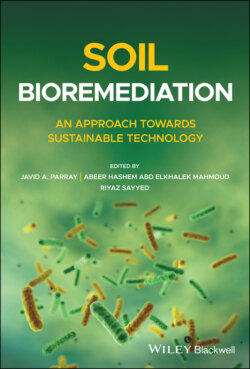Читать книгу Soil Bioremediation - Группа авторов - Страница 24
2.3 Impacts of Heavy Metals on Soil and Microbial Activity 2.3.1 Soil Microbial Community
ОглавлениеDifferent HMs have different effects on soil microbes and their processes however, some of these microbes might have evolved tolerance and adaptation mechanisms against HM in the soil environment [30]. Soil microbes are also biomonitors of HM pollution in soil. To check HM effects on soil microbes, microbes under study are divided into three groups, i.e., sensitive, tolerant, and resistant. It was established that resistance is evolved in microbes for HMs by the passage of time after repeated exposure [31]. Microbial colonies in Zn and Ti contaminated soils have decreased C contents, Zn shows biocidal effect and decreased microbial activity [32]. Soil microbial properties, microbial biomass, respiration, N‐mineralization, soil enzymes involved in cycling of C, N, P, and S were proven in response to different levels of HM pollution and it was revealed that microbial biomass and enzyme activities were reduced with increasing HM concentration. This implies that HM concentration in soils can severely decrease the functions of the soil microbial community and impair specific pathways of nutrient cycling [33]. In another study, results showed that microbial biomass in terms of C was depressingly affected by different levels of HMs. Enzyme activity was significantly dejected by HM stressed conditions. Soil phosphatase enzyme activities were found in the soils 200 m away from the HM [34, 35].
